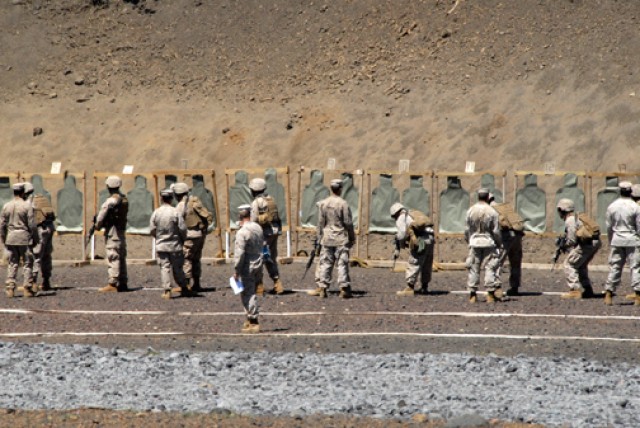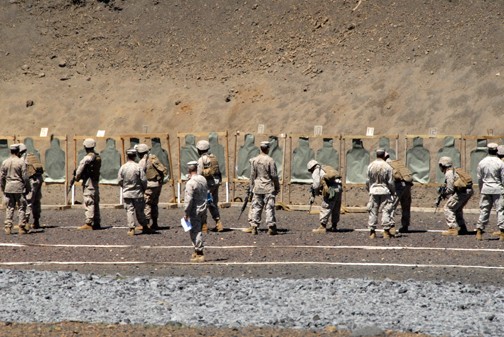POHAKULOA TRAINING AREA, Hawaii - The heavy, pop-pop, whirring sound of two Black Hawks deepened as the helicopters prepared to land on the heat-cracked runway at Bradshaw Army Airfield, here, April 12.
The Black Hawks carried 13 civilians who had flown from Wheeler Army Airfield to learn more about Pohakuloa Training Area, or PTA.
PTA, one of U.S. Army Garrison-Hawaii's 22 installations, is the largest military training area in the state of Hawaii. Its extensive, high-altitude, maneuver area replicates the harsh conditions that Soldiers from the 25th Infantry Division and Hawaii Army National Guard will encounter in Afghanistan.
Marines from the 3rd Battalion, 3rd Marine Regiment, Marine Corps Base Hawaii, Kaneohe Bay, also sharpen their combat skills, here.
The civilians are in the USAG-HI Fellows Program. Overseen by USAG-HI's Workforce Development Division, the 12-month Fellows Program grows leaders, supervisors and staff. Fellows visit USAG-HI directorates and activities, each month, to learn more about the garrison's mission of supporting Soldiers and their families.
Dr. Peter Peshut told the fellows about PTA's natural resources. Peshut, a biologist, here, works for the Natural Resources Section, Environmental Division, Directorate of Public Works, USAG-PTA, and is also a fellows candidate.
PTA is located on the saddle between Mauna Loa and Mauna Kea volcanoes. The 132,000 acres or 210 square miles that makes up the military's training area here is home to one of the world's rarest ecosystems: a tropical, sub-alpine and dryland ecosystem.
Peshut and the PTA Natural Resources staff identify, manage and protect 15 threatened and endangered plant species while maintaining a cultivation and planting program.
The same emphasis placed on identifying and preserving PTA's fragile environment is given to PTA's cultural resources. Dr. Julie Taomia, PTA's archaeologist, Cutural Resources Section, Environmental Division, DPW, USAG-PTA, told the fellows about the efforts she and six full-time contract archaeologists conduct.
The Cultural Resources Section manages more than 300 state-registered archaeological sites. They also periodically monitor more than 35 archaeological sites for effects from troops and hoofed mammals, or ungulates, such as pigs and goats.
She said carbon dating shows that native Hawaiians spent time in the area as far back as the 1400s-1600s. These ancient visitors left behind cultural shrines, habitation caves, burial sites and pictographs.
Fellows also visited several of PTA's 26 training ranges and then took an aerial tour of the training facility.
Robert Musgrove said in an email that the aerial tour put PTA's size in perspective. He had visited PTA "many years ago," but had only seen a small portion. Musgrove is an architect at the Master Planning Division, Directorate of Public Works, USAG-HI.
"I developed a better understanding of the cultural remnants that we are trying to preserve, as well as a better understanding of the importance of PTA to the Department of Defense in the Pacific," Musgrove said. "Understanding what the Soldiers must endure while training at PTA helps me to appreciate the commitment and sacrifice they must make."
Unlike Musgrove, Aimee Chong Wond had never visited PTA. She, too, was surprised, at PTA's enormity. Wond is a training coordinator for USAG-HI's Directorate of Family and Morale, Welfare and Recreation. She said in an email that she learned about the "...importance of the training area to our Soldiers' mission as the 'walking' stage in preparing the Soldiers for deployments."
Another fellow, Michele Santos, said in an email that PTA needs better support (funding and personnel) that will ensure Soldiers and Marines get the best "hands-on, live-fire training." Santos is an auditor at the Internal Review and Audit Compliance Office.
"We are all here to support our warfighters; (we) need to ensure that they have what they need ... before they deploy," she said.
View more photos on Flickr at http://www.flickr.com/photos/usag-hi/sets/72157626492069488/.




Social Sharing